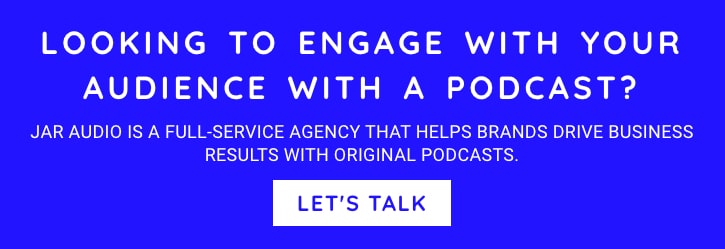Why podcasts are the only bet that pays compounding returns.
Enterprise marketing teams have turned into gamblers.
I watch them every day. They pull content levers like slot machines, hoping for pipeline magic. They spray random blogs and webinars across quarters, praying something pays out.
The casino always wins.
The tell-tale signs of marketing gamblers
You can spot marketing gamblers from across the boardroom. They obsess over weekly lead counts instead of building lasting assets.
They churn out panic content near quarter-end. And more often than not, there’s no editorial line and no audience strategy. Just more chips on the table.
When competitors launch TikTok clips, they immediately want TikTok clips. When rivals try LinkedIn carousels, they demand LinkedIn carousels. Strategy becomes mimicry.
Ask them what their content is supposed to achieve and you’ll get vague answers. “Brand awareness.” “Thought leadership.” Translation: they’re betting blind.
The data supports this chaos. 36 percent of marketers don’t even know which traffic source generates their most valuable leads.
I’ve been on the receiving end of this chaos. Early in my career, I worked at an agency where every quarter-end turned into a frantic scramble. I remember being told to “just get something out”, like a random blog, a social video nobody asked for, or a webinar we had no time to promote. It felt like throwing dice. Nobody asked if it was useful to sales, to customers, or even to our client’s brand. The measure of success was simply: did we get it out the door before the CFO’s deadline? That’s classic panic betting.
The brutal question that changes everything
Before any content gets created, I make teams answer one question: What job is this content being hired to do?
Not “raise awareness.” That’s gambler talk.
A real job means something specific. Help sales open doors with CIOs. Build loyalty so renewal rates climb. Position the brand as credible before a product launch.
This question forces trade-offs. If the job is pipeline support, guest strategy shifts toward prospects and partners. If it’s loyalty, content skews toward existing customer value.
It sets the scoreboard. You don’t measure “awareness.” You measure meetings booked, renewals, or market perception shifts.
Most importantly, it protects budget. Finance teams cut “nice-to-haves.” They fund tools that do actual jobs.
Walking teams off the casino floor
Once the job is clear, I show them why podcasts do that job more reliably than their current gambling habits.
Take RBC’s Disruptors podcast (it’s one of ours at JAR). At the start, the job was clear: position RBC as the authority on Canada’s innovation economy. That clarity shaped everything, from who the guests were and how the editorial line was drawn, to how we measured impact (increased share of voice in innovation conversations, not raw downloads).
Now, years later, the podcast has become a trusted stage for Canada’s most important business conversations. Each episode still attracts new listeners, but more importantly, the show has compounded into an archive of authority that RBC can point to again and again. That’s what an investment looks like.
But if you ignore this the compounding effect hits first. A webinar dies when you close Zoom. A whitepaper dies when it hits procurement’s inbox.
A podcast episode keeps working. Someone listens today, someone else next quarter, someone else when they finally hit that exact pain point six months later.
Content with shelf life, not fireworks.
Then I contrast attention patterns. Nobody wakes up thinking, “I can’t wait to read a PDF.” But people choose podcasts for workouts, commutes, cooking dinner.
Voluntary attention is rarer and stickier than forced attention.
The completion data seals the deal. 87 percent of listeners finish entire podcast episodes. Most webinars lose participants before 90 percent completion.
That gap reframes the entire risk equation.
Podcasts as risk mitigation
I never sell “a podcast.” I sell dependability.
Events get canceled. Algorithms change. Ad costs spike. Podcasts sit in feeds, archives, and search results. They de-risk the volatility.
The reliability factor builds trust through predictable publishing cadences. When 78 percent of enterprise marketers struggle to maintain consistent content streams, podcasts create systematic audience building.
Unlike the spray-and-pray approach, podcast strategy ties directly to the job you defined. Customer loyalty? Consistent series build deeper trust than one-off campaigns. Sales enablement? A library of conversations with decision-makers beats any single downloadable deck.
The investment mindset
Podcasts transform marketing from expense to investment. Episodes compound over time, building authority archives that attract listeners long after publication.
This creates owned media assets instead of rented attention. Your podcast feed belongs to you, not to algorithm changes or platform policies.
The measurement story changes too. Instead of vanity metrics, you track sustained engagement, returning subscribers, and business impact tied to the specific job your podcast performs.
Real investors know what their money is supposed to do and measure against that outcome. Gamblers just want lucky streaks.
Building your content fortress
The smartest enterprise teams are shifting from campaign thinking to asset building. They recognize that modern content strategies must balance innovation with reliability.
Podcasts provide that balance. They offer creative flexibility within a predictable framework. Consistent publishing schedule, growing archive, compound audience growth.
While volatile marketing tactics burn budgets, podcasts appreciate over time. Each episode adds to your authority bank. Each listener becomes part of a growing community.
The difference between casino play and strategic investment is simple: investors know what job their content is supposed to do, and they measure against that outcome.
Stop gambling with your marketing budget. Start building assets that compound.
Roger transitioned from a 22 year career in advertising account management to co-founding JAR, a podcast podcast production agency. As CEO of JAR, he propels the company’s growth by prioritizing audience engagement and podcast marketing. Under his guidance, JAR flourishes with a global clientele, aiming to broaden its reach across North America and revolutionize brand connections through immersive storytelling.



